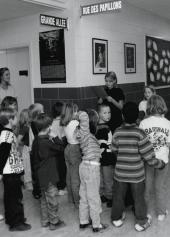
Saskatchewan was the second province in Canada to implement a French Immersion program in the public Education system for non-Francophones. In 1968, Saskatchewan and British Columbia opened their first publicly funded French Immersion programs. The Saskatoon Catholic school board, at the request of parents, opened the first early Immersion program. In 1969, a second program opened in Regina under the jurisdiction of the Regina Catholic School Board. The teaching of 50% to 100% of the curriculum in French to grade one Children who did not speak French is known internationally as an innovative Canadian experiment. Research continues to support this approach to the teaching of French as a second language as the most effective in achieving functional Bilingualism by the end of high school.
The growth of the program in the 1970s and 1980s was attributable to the proclamation of Canada's first Official Languages Act (1969), as well as to the commitment and support of communities willing to try this approach to learning French.
In 1970, federal funds became available to support provincial French second-language programs; in Saskatchewan, the federal government support has continued since that time. These funds have translated into consultant support, curriculum development opportunities for French second-language teachers and administrators, the Official Languages Monitors Program, and student bursaries. Saskatchewan's Education Act (1978) enabled instruction in publicly funded schools to be conducted in a language other than English. An Official Minority Languages Advisory Committee was formed in the 1977-78 school year, and by 1980 the Official Minority Language Office was established to support the development of French language education in Saskatchewan.
The first Saskatchewan graduates of a French Immersion program received their diplomas in 1981 with the introduction of the “bilingual mention” qualification on the student high school transcripts in the fall of 1992. The number of students in French Immersion or bilingual programs increased annually by over 20% in the first half of the 1980s. A unique French teacher education program at the University of Regina responded to the growing demand for bilingual teachers trained in second language teaching and Immersion methodology. The number of kindergarten to grade twelve students in French Immersion programs in the province of Saskatchewan continued to increase until 1990; some large urban school divisions had as many as 30% of their kindergarten students enrolled in French Immersion programs during the late 1980s.
With the development and introduction of Saskatchewan Core French curricula for grades one to twelve in the late 1980s, a number of school boards introduced the new Core French program in their schools. Core French is defined as the study of French as a second language for 120-150 minutes per week, with various entry points from grade one to grade seven. The numbers of students in French Immersion declined as this alternative means of second language learning became more readily available By the 1993-94 school year, 6.6% of all the children in the province were enrolled in French Immersion or bilingual programs. In 1994-95, the Fransaskois school boards were formed, and over 1,000 students were transferred from French Immersion programs in anglophone school boards to the newly formed jurisdiction. Approximately 5.6% of the students in the province remained in French Immersion programs.
The political unrest that characterized Quebec-Canada relations during the 1990s is thought to have been one of the factors in a significant decline in the percentage of students enrolling in French Immersion in the province: from 1996 to 2001 the percentage of “bilingual” 15-19-year-olds decreased from 10.7% to 9.9%, producing one of the lowest rates of provincial bilingualism in Canada. The first non-Francophone parents to advocate for and choose French Immersion for their children tended to be university-educated persons who believed in the value of a second language in the education of a child; but they also were likely to be committed to a bilingual Canadian nation. By the year 2000, the children in French Immersion represented a more typical cross-section of the diverse school age population. Over the thirty-seven years of French Immersion in Saskatchewan, parents' motivation evolved from choosing French Immersion for their child in support of the linguistic duality of Canada and future employment advantages, to a search for a more challenging academic program and the acquisition of the cognitive benefits of bilingualism; in some cases, it is also a result of their awareness of the increasing globalization of our world.
Mary E. Reeves
Print EntryHOME | BROWSE BY SUBJECT | ENTRY LIST (A-Z) | IMAGE INDEX | CONTRIBUTOR INDEX | ABOUT THE ENCYCLOPEDIA | SPONSORS TERMS OF USE | COPYRIGHT © 2006 CANADIAN PLAINS RESEARCH CENTER, UNIVERSITY OF REGINA | POWERED BY MERCURY CMS |
|||
| This web site was produced with financial assistance provided by Western Economic Diversification Canada and the Government of Saskatchewan. |
|||
 |
 |
 |
 |
| Ce site Web a été conçu grâce à l'aide financière de Diversification de l'économie de l'Ouest Canada et le gouvernement de la Saskatchewan. |
|||